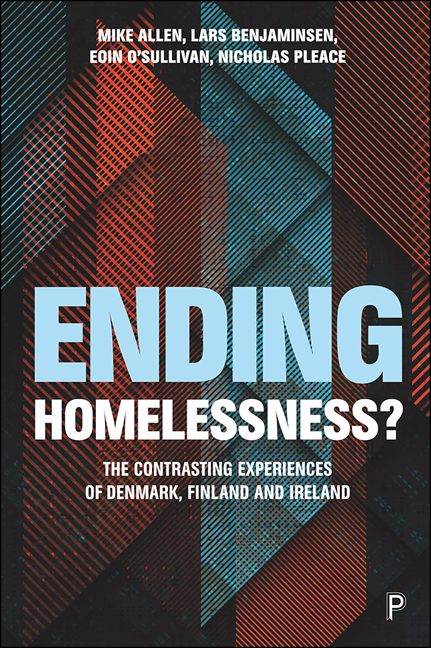Book contents
- Frontmatter
- Contents
- List of Figures and Tables
- Acknowledgements
- 1 Ending Homelessness? Policy and Progress in Denmark, Finland and Ireland
- 2 Before the Goal of ‘Ending Homelessness’: the Evolution of Policy
- 3 The Strategies Described
- 4 Trends in Homelessness in Denmark, Finland and Ireland
- 5 Explanations: Housing Matters
- 6 Explanations: Welfare and Politics Matter
- 7 Conclusion
- References
- Index
5 - Explanations: Housing Matters
Published online by Cambridge University Press: 25 February 2021
- Frontmatter
- Contents
- List of Figures and Tables
- Acknowledgements
- 1 Ending Homelessness? Policy and Progress in Denmark, Finland and Ireland
- 2 Before the Goal of ‘Ending Homelessness’: the Evolution of Policy
- 3 The Strategies Described
- 4 Trends in Homelessness in Denmark, Finland and Ireland
- 5 Explanations: Housing Matters
- 6 Explanations: Welfare and Politics Matter
- 7 Conclusion
- References
- Index
Summary
Introduction
In Chapter 4, we explored in some detail both the construction of homelessness data in Denmark, Finland and Ireland and what these data tell us about trends and the composition of those households experiencing homelessness.
While the construction of homelessness data in the three countries varies significantly in terms of methodology and the definition of who is considered homeless in the official statistics, it was possible to identify a number of common categories of homelessness in all three countries, namely, those in temporary and emergency accommodation and those rough sleeping. Both the Finnish and Danish data also include ‘hidden homelessness’, but the Irish data do not. As we have shown, whether you explore trends using the country-specific definition or the more restricted comparable definition, similar trends are evident. The numbers of people experiencing homelessness declined consistently in Finland over the past decade and increased slightly in Denmark, while Ireland experienced hyper-homelessness.
The purpose of the remaining chapters is to explore how three countries that started the 21st century with relatively modest and similar numbers of homeless households, and expressed similar levels of ambition to reduce homelessness, ended up with different experiences in the second decade. In this chapter, we first explore the role of Housing First in the three countries, and then go on to contextualise this in the broader housing market, particularly social housing. The impact of welfare policies and political choices will be explored in Chapter 6.
The role of Housing First
The adoption of Housing First as an approach to tackling homelessness features strongly in the story of the three countries. However, as has already been remarked, there are very considerable differences in the practices and broader context of what is referred to as Housing First in the three countries, and also in comparison with the Pathways Housing First approach pioneered by Sam Tsemberis (2010a) in New York in 1992.
Finland is sometimes portrayed as shifting everything into Housing First in 2008 and, in so doing, ‘solving’ homelessness, essentially through importing and adapting the model that Sam Tsemberis developed across the Atlantic 15 years earlier.
- Type
- Chapter
- Information
- Ending Homelessness?The Contrasting Experiences of Denmark, Finland and Ireland, pp. 103 - 138Publisher: Bristol University PressPrint publication year: 2020

